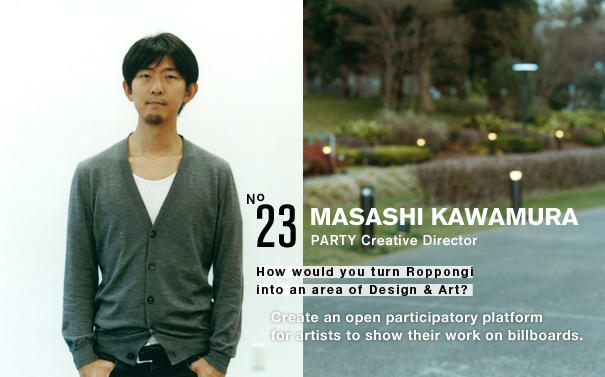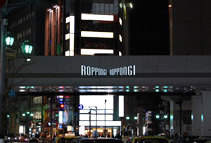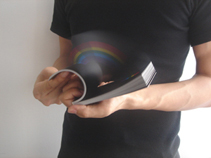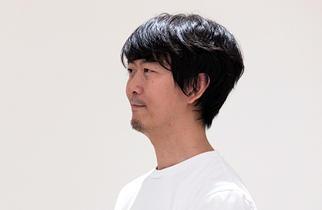
23 Masashi Kawamura (PARTY Creative Director)

- JP / EN
PARTY is a "creative lab" founded in 2011 by a group of renowned Creative Directors in the advertising world. One of its co-founders is Masashi Kawamura, a rising creator who also works in many fields outside of advertising - planning and producing flip books, music videos, and the NHK TV program "TECHNE: The Visual Workshop". Kawamura is such a busy person that when we asked him what interests him most at the moment, he candidly replied "taking a rest." Nonetheless, when we asked him how we could turn Roppongi into an area of design and art, he came up with a steady stream of ideas.
Transform the streets of Roppongi into an art museum
It's a wonderful thing to have lots of art museums and galleries in a town, but I think it's a shame to keep works of art and design locked up in such limited spaces. I think art and design should be part of our ordinary, everyday lives. Spaces for exhibiting works shouldn't be restricted to art facilities; the roads and street corners could become exhibition spaces too; it would be good if the whole area of Roppongi couldbe like a huge art museum and literally become an area of design and art.
This is just an idea, but how about letting artists show their works on all the billboards and signboards in the streets - giving them free rein on every advertising medium in Roppongi?
What I envisage is a really open project where artists can use every available advertising space, small or large. There's an infinite amount of space - simply in the number of billboards alone. The project could last for about a month or perhaps for several days to coincide with events such as "Roppongi Art Night." I think there are many ways to do this; for example, existing billboards could be temporarily covered with paper. I just think it would be so interesting if Roppongi as a whole became like an expanded canvas for free expression.
An idea that involves everyone's participation
Under this project, all the advertising space in town will show art, so the map of the streets of Roppongi will be the equivalent of the floor map in a museum. Just as you would find a work of Monet in a certain room, it would be nice if you could walk around with a map in hand and find a work by someone like Banksy in a certain street for example. This way, people who don't usually have the opportunity to see art will be able to enjoy it; people who had not come to Roppongi specifically to look at artwork might have some unexpected encounters.
I think we should seek the participation not only by leading professional artists, but also of young, unknown artists as well as students. We might even be able to gain the cooperation of advertisers if we could agree on how the names will be displayed. It should be a project engaging many people as possible. If you want people to look at Roppongi as an area of design and art, I don't think you should do things like make a single piece of artwork and one-sidedly say that it represents Roppongi's view of art. It's important to come up with an idea that involves everyone's participation - it should be something that we can all create together.

The billboard at Roppongi Crossing has been digitally altered in this photograph to look like a white canvas. The billboard could be accommodated for the artwork or the artwork could be adjusted to fit the size of the existing billboard. Some artists may not care either way. It would be interesting to see what approach each artist will take.
Creating an online platform
In addition to an idea that involves everyone's participation, we need to create a platform. For example, we could make something online that is similar to the (Google) Street View where you can walk through the Roppongi streets. In this Street View, all the billboards and advertisement spaces are white. When you click on a blank billboard, a message pops up, asking if you would like to reserve that space. Information is also offered on details such as the size of the advertisement space. You click "yes", and create an image for that size. When you upload it the image soon gets printed, and you are informed of the date and month when it will be put up on the billboard.
We at PARTY could make the foundation for such a system. The point is that Roppongi as a whole will be like an art museum, and I wouldn't necessary have to createa piece of artwork myself. What's necessary is a system that can be used by everyone. I'm very interested in creating that kind of platform - the tools that can be used by everyone.

The "before" and "after" parts of the creative experience
My interest in building platforms and tools reflects my interest in the whole experience of projects. When I made the music videos for SOUR and androp for example, I kept telling people around me that I was doing this for the wholesome experience, including the"before" and "after" of the content itself. Some people think that a music video is finished when you've created the film. In my view, there is the "before" part which is about exploring new methods to create it. I might choose not to use an ordinary video camera but shoot with a web camera instead, or I might make an animation using the camera flash. I feel that the creative methods in themselves are part of the story.
SOUR "Mirror"
And for me, the "after" part of a music video is about how it gets sharedand how people experience it. Instead of a music video that you just passively look at, I think your experience of the music can become much deeper if you can enjoy it in an interactive way; if you can personalize a music video, you would want to share it with others. These are the factors I have in mind when I try to make things that resonate with people, and that's why I've made a video version and game version of few of my music video projects.
New ways of creating and conveying phenomena
As for my idea to let artists freely use billboards, the end result would be streets filled with all kinds of works by artists. But if I were allowed to design the platform, I would love to think about every aspect of the project. For example, I would think about the "before" part: how we could make an online platform that allows for easy participation, and I would think about the flow: how the system would be made and what tools will be required, and then I would think about the "after" part: how to make the map to help people walk the streets and appreciate the artworks.
I don't think the innovativeness of individual artworks is enough to turn people's heads. For Roppongi to get attention, it needs a new experiment - a phenomena that has been created by new methods or that is conveyed in a new way. That would have much more impact than any art exhibition. That kind of project would be something which Roppongi as a whole will need to undertake, and it would get the message across to people that Roppongi is serious about becoming an area of design and art.
Nothing can surpass a real experience
"Experience" is the key word that best describes what most interests me in work. I'm interested in things that are tangible and real. When working with images and the digital realm, you tend to have much of your experiences via the screen. That essentially means you're not using the senses like touch and smell. But I feel that however hard you try, what happens on the screen is never going to be as good as a real sculpture or a live event.
I actually don't like centering my thoughts on digital things. Social media and technology have advanced so much now, and I use the various skills and tools because they are available to me, and help me to get people involved. But it's not as if I have this urge in the first place to make something interactive or digital. For example, it would be perfectly fine to simply make a sculpture if that happens to be the best way to get the message across. What interests me is how I can combine technology with the tangible things; the method of combining them is what I want to keep on exploring.

A city that gives you the feeling of belonging
From age six, I grew up in San Francisco; I went to high school and university in Japan, but after that I've spent much of my life abroad - living in and working in countries such as New York, London and Amsterdam. Of the cities I've known, I like New York best. It's the most open city. Whatever nationality you are, people accept you as a New Yorker the moment you start living there. Relationships are flat and equal, and it's wonderful how they make you feel that you belong to the city.
If you were to ask me about problems in Japan, there are probably some things I could point out about design, but the most pressing problem seems to be that Japan is still very much a closed society. When I come back from abroad, I'm taken aback to see that there are only Japanese walking in the streets. Perhaps it's partly due to the language barrier, but even in Tokyo, there isn't much exchange with foreigners. One of the reasons why I work abroad is that it allows me to spend time with people from all kinds of cultures with different values. By spending time together, I can learn about the differences as well as about the things that we have in common as human beings.
Things that resonate with people of all cultures
Working on advertisements involves trying to reach a large audience, and I often think about what resonates with people; I wonder about the kind of things that can draw empathy. When I work with English people and Dutch people for example, our cultures may be very different, but I find that there is always something we have the same viewpoint on. I feel as if I've traveled to other countries in order to discover what that common perspective is. It's possible to discover that in Japan as well, but I think when you're immersed in a limited environment in just one culture, the place becomes the whole world to you, and it gets harder to be alert to the essence of things.
Roppongi is probably the most international district in Tokyo. There are lots of foreigners in the standing bars, and I wish we could take that cross-cultural aspect one step further. I wish that the seeds of cultural exchange could grow in places other than the places you go to for drinks and fun. It would be nice if Roppongi becomes a place that has things of significance for people of all nationalities.
Good ideas for toys and snacks
In 2007, I made a flip book called "Rainbow in your hand." When I'm not at work, I'm usually working on my personal projects. Since I'm always working in my spare time, I find that I have little time to rest. (laughs)
It would be ideal if you could go to a manufacturer and make a proposal for a product immediately after an idea comes to you. I don't have that many connections though, and it takes time to become acquainted with people. With "Rainbow in your hand", I personally got it printed and went around selling it. And then I had the good fortune of meeting Hiroshi Eguchi of (the bookstore) Utrecht who offered to take care of the printing and distribution matters.

Rainbow in your hand
Right now, I have some ideas for toys and snacks, and I'm really hoping they will be made into products. The ideas are fabulous, if I may say so myself! I want to make candies which are very conceptual; I'm sure they would sell. Both the toys and candies I have in mind would probably not be all that difficult to make. My company would do the branding for them. If there are any snack makers or toymakers that would be interested in working with us, please contact us! Since I'm making the request here, let me add that we would particularly welcome companiesin Roppongi.
Editor's thoughts
In taking the photo, we employed a method similar to the "multi-screen" technique shown in the TV program "TECHNE: The Visual Workshop". Kawamura-san was cooperative throughout the photo session, smiling pleasantly. "When the picture comes together, I hope my hair doesn't look like Vegeta's!" he said laughingly, referring to the "Dragon Ball" anime character. (edit_rhino)
information
An exhibition of "TECHNE: The Visual Workshop", directed by Masashi Kawamura will be held at Tokyo Midtown Design Hub from March 1st to 31st. Visitors will be able to see and experience the various techniques used in film-making. We hope that you will visit this exhibition which is rich in substance.



















